Posterolateral refers to the position at the back and to the side of a structure, commonly used to describe specific areas in the body, particularly in the knee and spine.

Posterolateral Drawer Test
Learn about the Posterolateral Drawer Test procedure and interpretation for knee instability and injuries. Download our free template for accurate assessment.
Use Template
Posterolateral Drawer Test Template
Commonly asked questions
The posterolateral corner of the knee includes structures such as the lateral collateral ligament, popliteus tendon, and the popliteofibular ligament, which help stabilize the knee.
Posterolateral force refers to a force applied towards the back and side of a structure, often used in clinical tests to assess the stability and integrity of ligaments and joints.
EHR and practice management software
Get started for free
*No credit card required
Free
$0/usd
Unlimited clients
Telehealth
1GB of storage
Client portal text
Automated billing and online payments











